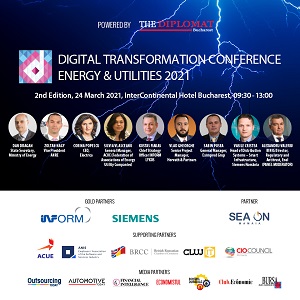The Diplomat – Bucharest organizes the second edition of DIGITAL TRANSFORMATION IN ENERGY & UTILITIES on March 24 in Bucharest, within a hybrid event with LIVE transmission and held at InterContinental Hotel Bucharest.

Energy 4.0 is here and the digitization of this strategic sector implies the widespread use of digital machines and devices at all levels of the power system, from production and infrastructure to end-user devices. Energy 4.0, as it is known, enables the industry to implement intelligent energy and power management solutions based on machine to machine and machine-human interactions.
In this context, the energy sector is undergoing a transformation process and it tackles new business models and new priorities. The utilities industry: electric power, water, or transportation stands at the forefront of technology advance and the organizations and their CIOs should have a comprehensive digital assurance platform to prevent future challenges.
ENERGY-AS-A-SERVICE (EAAS) | BLOCKCHAIN SMART METERING | CYBERSECURITY DIGITIZATION & DIGITALIZATION IN ENERGY
CONSUMER EXPERIENCE TRANSFORMATION
PANELISTS
- DAN DRAGOS DRAGAN, Secretary of State, Ministry of Energy
- ZOLTAN NAGY-BEGE, Vice-president, The Romanian Energy Regulatory Authority (ANRE)
- CORINA POPESCU, CEO, Electrica
- SILVIA VLASCEANU, General Manager, ACUE (Federation of Associations of Energy Utility Companies)
- KOSTAS FIAKAS, Chief Strategy Officer, Inform Lykos
- VLAD GHEORGHE, Senior Project Manager, Horváth & Partners Management Consultants
- SABIN POSEA, General Manager, Eximprod Grup
- VASILE CRISTEA, Head of Distribution Systems – Smart Infrastructure, Siemens Romania
- ALEXANDRU-VALERIU BINIG, Director, Regulatory and Antitrust, Enel (DEBATE MODERATOR)
AGENDA
REGULATORY & AUTHORITIES UPDATES
Outlook and updates of current regulatory policies and the view of authorities on the evolution of energy sector in Romania. European directions and objectives, local outcomes and perspectives on the transformation of energy sector in Romania
- Is there a proper coordination between the authorities regarding the management of state aid for the energy sector?
- Is Romania “doomed to decentralization”?
- What projects in the energy sector are still receiving funding these days?
- What should Romania do to facilitate the energy transition. Do we have the money to finance digitalization both in regulated and competitive activities?
ENERGY DISRUPTIVE SOLUTIONS & INNOVATIONS
The energy sector is a particularly interconnected industry and whilst the digitalization is driving growth and innovation, it also increases the need to secure the smart grid.
DEVELOPING SMART METERING INFRASTRUCTURE FOR THE DIGITALIZATION OF ROMANIA’S ENERGY SECTOR
FINANCING SMART METERING DEPLOYMENT THROUGH THE RECOVERY AND
RESILIENCE FACILITY
- What is the status of Romania in terms of recovery and resilience plan setting out the reform and investment agendas?
- What is the The Recovery and Resilience Facility’s budget share for Romania and towards what kind of projects will go the funding?
- Which are the opportunities and draw backs of developing the smart metering in Romania?
SAFETY & CYBERSECURITY IN ENERGY
Cyber Security is a major concern of the European Commission, which will issue new directives for cyber security of critical infrastructures. Blockchain is also a cyber security solution in the field of electrical networks and the acquisition of operational data for the management of the system – not only for commercial transactions.
- Which are the main threats in terms of cyber security in energy in Romania and how do we stand compared to the European countries?
- What measures are the most often used by companies to prevent and fights against cyber threats?
- Where are the strongest liabilities and vulnerabilities in terms of cyber security in the energy sector? What kind of companies, operations, etc.?
ENERGY-AS-A-SERVICE (EaaS)
Some visions of the energy system in the future mainly revolves around distributed energy resources (DERs) that are monitored by a combination of AI and IoT. Together with blockchain and a growing number of energy prosumers, these components comprise energy-as-a-service solutions. EaaS allows for the transition from selling electricity to selling services such as consumption management, optimization of production, and tracking consumption. The presence of local energy sources and storage options accelerate energy efficiency across the grid while providing access to more people.
- Energy efficiency & optimization segment is expected to dominate the EaaS market from 2018 to 2023.What is Romania’s perspective and strategy in this respect?
- Which are the main dialogue partners in enhancing energy efficiency through using new technologies?
- How is it practically applied EaaS in Romanian energy field?
BLOCKCHAIN APPLICATION IN ENERGY
Blockchain technology intends to unite all energy stakeholders under a single decentralized network. Electricity producers, distribution network operators, metering operators, providers of financial services, and traders potentially benefit from utilizing smart contracts. These contracts ensure that all energy-related transactions pass through a secure and immutable network, thus eliminating potential losses. Blockchain also holds the potential for achieving some degree of equality between energy producers and consumers by making electricity affordable for more people.
- What applications in blockchain technologies are applied in Romania and what is the objective?
- How can it be translated in terms of customers’ benefits the blockchain applications?
- What should the large population (customers, energy stakeholders) should understand from the application of blockchain technologies in energy in Romania?
CUSTOMER EXPERIENCE ENABLED THROUGH DIGITIZATION
Digitization is essential in the transformation of Customer Journey, a key element in maintaining the energy portfolio of customers of energy suppliers. Digitization and digitalization across the energy landscape triggers the system-wide changes of connectivity by linking, monitoring, aggregating and controlling assets along the entire chain, from producers, suppliers and consumers.
- What is the evolution of digitization and digitalization in energy sector in Romania and which ae performers of the industry in this respect?
- Which are the opportunities and challenges of digitalization in Romanian energy?
- How do you actively engage customers digitally in energy sector?
EVENT WEBSITE